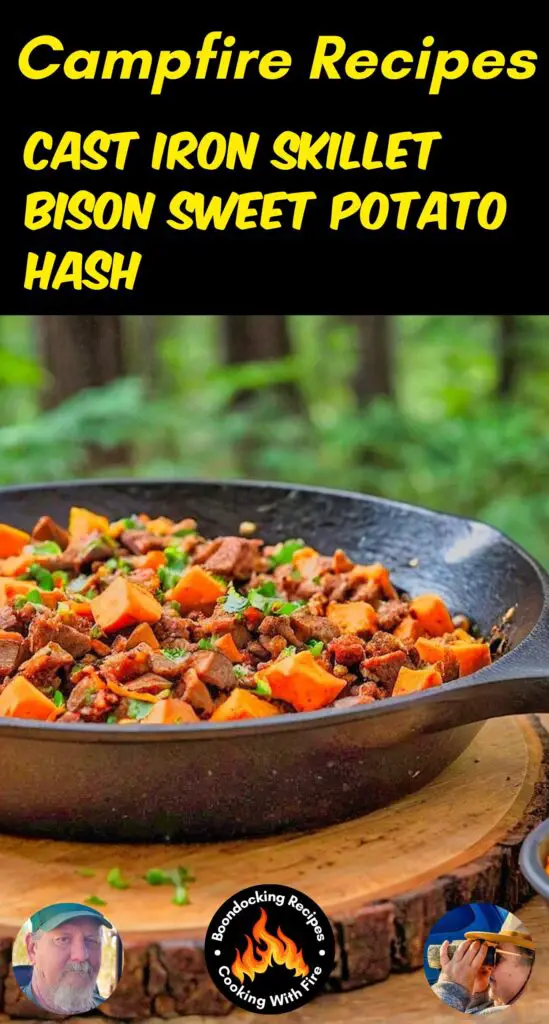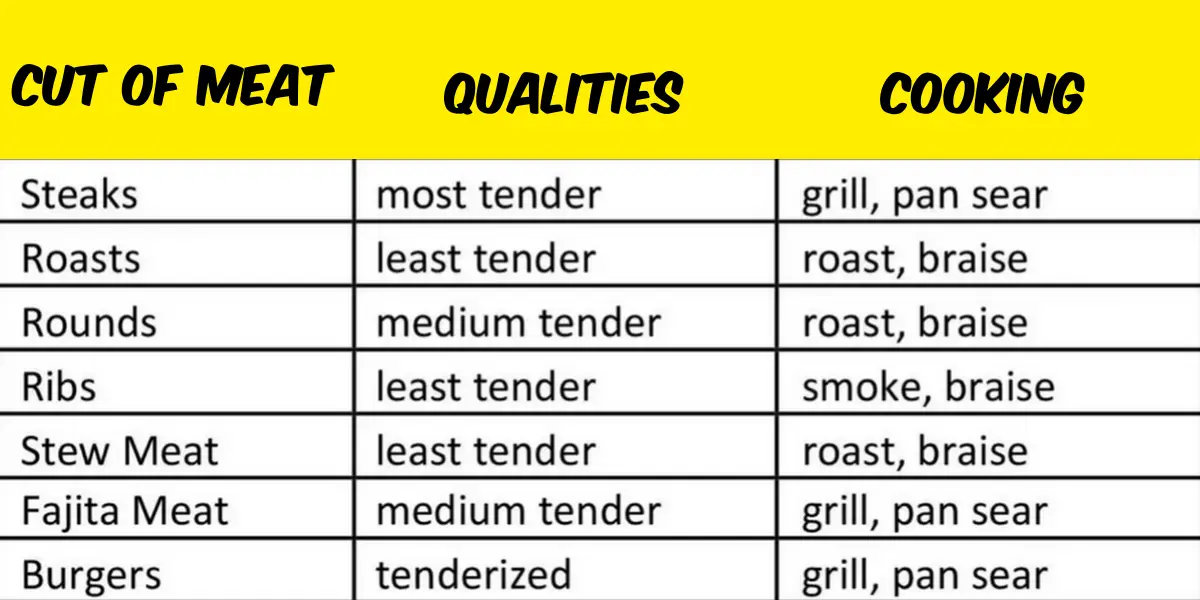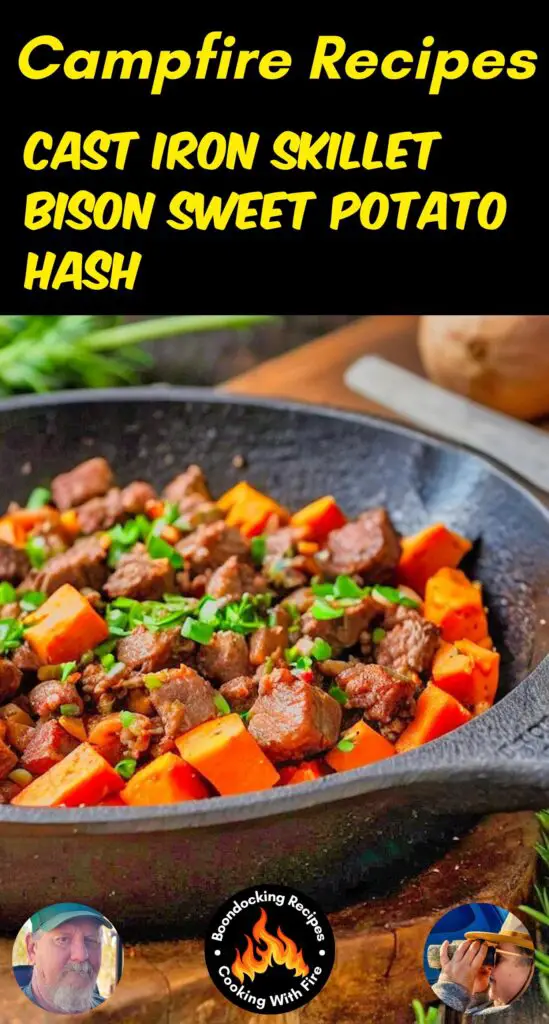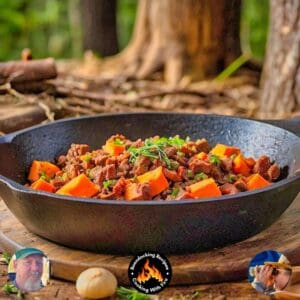
This cast iron skillet bison sweet potato hash recipe is one of our go-to meals for outdoor cooking. This dish is simple yet satisfying, perfect for enjoying the great outdoors. My husband and I love cooking with bison because it’s leaner than beef but still full of flavor. The sweet potatoes add a nice sweetness that balances the savory bison.
We find that the cast iron skillet is ideal for this recipe. It heats evenly and holds its temperature well, which is important when cooking outside. The skillet gives the bison a nice sear and makes the sweet potatoes crispy on the outside while staying soft on the inside.
It’s easy to use a cast iron skillet, and the results are always delicious. We enjoy the simplicity of preparing this meal. There’s something special about being outdoors, smelling the food cook, and hearing the sizzle in the skillet.
The cast iron skillet bison sweet potato hash recipe is also very adaptable. You can easily add other vegetables to the mix. We often throw in some bell peppers or onions, depending on what we have. This dish is perfect for using up whatever fresh produce you have on hand.
One of the best things about the cast iron skillet bison sweet potato hash recipe is how filling it is. After a day of hiking or exploring, it’s nice to sit down to a warm, hearty meal. The combination of bison and sweet potatoes provides plenty of protein and carbs, giving us the energy we need for our hiking trips.
Cooking Instructions For the Cast Iron Skillet Bison Sweet Potato Hash Recipe
- The first step of making the cast iron skillet bison sweet potato hash is to start your fire or charcoals. You will using them for the cast iron skillet bison sweet potato hash, so you will want to make sure you have plenty on hand.
- If using embers, get a large fire going using (preferably) hardwood and let it slowly burn down. This process from start to finish can take upwards of an hour.
- If using charcoals, fill a large chimney starter and light. This process will take approximately 20 minutes to get all the coals hot and ready. You will likely want to have some charcoals available in reserve.
- Add a fire grate to the burning embers.
- Melt the bacon grease in a cast iron skillet over medium-high heat. Spread the potatoes out into a single layer. Trust me, cover and walk away for approximately five minutes. If you continue to stir, the potatoes will not color properly.
- Flip with a spatula, cover, and walk away for another five minutes. Uncover and test the potatoes to ensure they are soft throughout; cook for a few more minutes if required until done.
- Cook for about 5 minutes, or until the bison and onion are fully cooked. Add the kale and simmer for another 2-3 minutes, or until wilted. Add salt and pepper to taste. If desired, add a fried, pasture-raised egg.
- Uncover and serve.
Ingredients
bacon fat
potatoes
bison sausage
onion, diced
kale leaves
salt
pepper

5 Reasons I Love the Cast Iron Skillet Bison Sweet Potato Hash Recipe
1. It is delicious
If you like meat, you will like Bison. People describe Bison meat as tasting comparable to beef but richer and somewhat sweeter. However, because bison is so thin, it is crucial not to overcook it. Bison should not be cooked beyond medium. Of course, if you use ground Bison, this isn’t an issue.
Some people are afraid that Bison will have a gamey flavor comparable to venison; however, I have never found this to be the case. Bison, in my opinion, tastes better than any meat I’ve ever tasted. Bison meat is denser, richer in flavor, and more satisfying than beef, in my opinion.
2. Lean Protein
Food guidelines advocate bison as a lean protein alongside skinless chicken breast and other wild game meats, and for good reason. 100g of lean bison contains just 2.42g of fat, compared to 8.09g in lean beef and 9.66g in lean pig. The same 100g of bison contains just 82mg of cholesterol, compared to 86mg in the same quantity of lean beef, pig, and chicken. If you want to keep things lean and clean, Bison is an excellent choice. Figures sourced from the Canadian Bison Association website.
3. Lot’s of the Good Stuff Inside
In addition to being lean as well as low in cholesterol, bison is high in iron (3.42mg per 100g lean meat compared to 2.99mg in beef, 1.1mg in pork, 0.6mg in chicken, and.34mg in salmon), vitamin B12, B6, Niacin, and Zinc. Bison’s high iron content makes it an ideal choice for both men and women who suffer from anemia. In 2018, Thehealthy.com (part of Reader’s Digest) identified bison as one of the 13 Superfoods Every Healthy Woman Needs in Her Diet because women are more susceptible to anemia, and bison delivers a high iron, low-fat choice to help address this issue.
Bison are raised without growth stimulants or hormones and are not regularly fed antibiotics.
4. It’s Sustainable
Bison are raised sustainably, contributing to the land’s development and biodiversity rather than depleting it. Because practically all of a bison’s nutritional demands can be supplied by *feeding on native perennial plants that grow natively in Canada, there is no need to overfertilize the soil. These grassland ecosystems would often be exploited for monoculture cultivation, such as grain or soybeans. Some monoculture farms have even been turned into more biodiverse bison grazing areas.
Raising a bison cow and her young requires between four and sixteen hectares of grazing space. However, bison live on, consume, and fertilize these enormous grasslands. Compare this to other commercial farming approaches that confine animals to limited quarters and raise their feed on monoculture farms. To be sustainable, these monoculture agricultural processes require a lot of acreage and artificial fertilizers. Of course, the feed must be moved from the farm to the animals.
5. You Already Know What To Do With It
One might be telling yourself, “This seems wonderful, but what do I do with it?” That is an excellent question. But here’s the thing: You are already aware of what to do with it. Let me ask you something: Have you ever cooked beef? If you said yes, you have your answer. You may make the same dishes you’ve always used; just substitute Bison for the protein. It is that easy.
Bison, The Meat of The Future.

Nutritional Facts for Meat Groups
I’ve been cooking with bison for more than a decade, at private dinners, and at home, and I’ve always liked it. An observation that has impressed me over the years is that bison ought to be more widely recognized than it is, and I believe it is about to be. I believe that as consumers seek for more sustainable meals and leaner meats, bison will gain appeal. There is a growing trend, and for good cause, of eating higher quality meat in lesser quantities. Bison, with its high caloric density and unquestionable quality, is the ideal protein for this future dietary standard.
If you’ve ever spotted Bison at the grocery store, thought about it, but then passed it up because you didn’t know what to do with it or how it would taste, I hope this has given you a reason to reconsider. I hope you try it because I am convinced that you will be pleased with the results.
Grass-fed, regenerative bison meat is superior in flavor, protein content, and nutritional density. Bison is a lean, soft, naturally tasty meat with a deeper taste profile and darker color than beef. Bison meat, unlike that of other exotic species, lacks a “gamey” or wild flavor and is typically thought to be sweeter. Bison meat is interchangeable in almost any red meat dish.
Bison steaks cook around 1/3 faster than beef steaks due to their thinner nature. Bison steaks are best cooked medium-rare (135°F)/medium (145°F) to keep the meat’s moisture and taste – this means taking the meat off the fire when it is approximately 5 to 10 degrees below your ideal temperature to account for the rise in temperature while it rests.
Bison Cooking Guidelines

Chart Showing Various Cuts of Bison
Steaks (Grill, Broil, or Pan-Broil)
Use steak ¾ to 1 inch thick
Place in lightly oiled skillet and use medium heat on stove top
Place bison on BBQ or 6 inches from the heat source in broiler
Cook 4 – 5 minutes per side
To increase tenderness, marinate sirloin tip and inside round steaks for 8- 24 hours
Roasts (Sirloin Tip, Inside Round)
Sear roast in oven at 500°F (260°C) or on stove in a hot pan
Season roast, add ¼ cup (50 mL) of liquid (water or red wine)
Roast at 325°F (165°C) in covered pan or place in slow cooker
Cook roast to medium rare 145°F (63°C)
Roasts (Rib, Loin and Tenderloin)
Use uncovered pan with rack
Season as desired to taste
Cook at 275°F (135°C)
Do not cook past medium 155°F (68°C)
Burger
Cook ground meats to 160°F (70°C) internal temperature
Make sure all patties sit flat on grill for entire cooking time.
Cooking equipment should maintain temperature of 375°F (190°C) even when loading continuously with frozen patties
Ground bison should always be cooked until no pink remains

Natural versus Organic—Bison Meat is Meat Raised Naturally
The term ‘natural’ does not mean the same as certified organic. Under Canadian labelling guidelines, a ‘natural’ or ‘naturally raised’ label claim is allowed only if animals were raised with minimal human intervention, such as bison. While we can’t claim our bison meat as certified organic, we can say that our products are about as natural and unprocessed as you can get.
Bison Meat Benefits
Bison meat is one healthy protein, but don’t just take our word for it. The U.S. and Canada’s food guides recommends bison meat as a ‘heart healthy lean protein’ for anyone, and many nutritional experts tout bison as ‘a step above beef when it comes to sustainability, heart health and even taste.’ Nutrient-dense bison meat is healthy because it’s:
Bison is lean meat with a similar texture, flavor, and appearance to beef, but its impressive nutrient profile uniquely supports an active lifestyle. With no carbs, only 2.1g of fat, and a whopping 24 grams of high-quality protein per serving, the health benefits of bison meat are extensive.
Promotes Muscle Recovery
The main appeal of bison is its high quality protein content. . Protein is essential for helping your muscles recover from a tough workout. With the high-quality protein that bison contains, your body can use it for muscle synthesis and utilize the naturally-occurring vitamins and minerals to support overall health.
Supports Bone Strength
Protein has been shown to have a positive association with bone strength, especially within the senior demographic. With bison possessing a very pure and high-quality source of protein, regularly consuming this lean meat can help improve muscle mass and bone strength, keeping individuals—particularly seniors—active and independent.
Great Source of Zinc
Just a 4-ounce bison patty can provide over 3 milligrams of zinc—an essential mineral for your immune system, metabolism, and healing wounds. Zinc from meat sources, such as bison, is more bioavailable than from vegetarian sources, which means that bison provides a form of zinc that’s easy for your body to absorb and utilize in the body.
Preventative Against Anemia
Anemia is associated with low intake or poor absorption of vitamin B12. Since bison is a good source of iron and vitamin B12, consuming it can help you avoid becoming anemic and experiencing symptoms of anemia such as fatigue, dizziness, paleness, and a rapid heart rate.

FAQ For the Cast Iron Skillet Bison Sweet Potato Hash Recipe
Other Bison Recipes to Try
Q: What ingredients are needed for the cast iron skillet bison sweet potato hash recipe?
– To make the cast iron skillet bison sweet potato hash recipe, you will need ground bison, sweet potatoes, onions, bell peppers, garlic, olive oil, salt, pepper, and seasonings such as paprika, cumin, or thyme. Optionally, you can add ingredients like spinach, kale, or eggs to enhance the dish.
Q: How do you cook the cast iron skillet bison sweet potato hash recipe?
A: To cook the cast iron skillet bison sweet potato hash recipe, begin by heating olive oil in a cast iron skillet over medium heat. Add diced sweet potatoes and cook until they start to soften. Next, add chopped onions and bell peppers, cooking until the vegetables are tender. Add minced garlic and cook for another minute. Then, add the ground bison, breaking it up and cooking until it is browned and cooked through. Season with salt, pepper, and your preferred seasonings. Stir everything together and cook until the flavors are well combined and the sweet potatoes are fully tender.
Q: Can I make the cast iron skillet bison sweet potato hash recipe ahead of time?
A: Yes, you can make the cast iron skillet bison sweet potato hash recipe ahead of time. Prepare the dish as directed, then let it cool and store it in an airtight container in the refrigerator for up to 3 days. Reheat the hash in the skillet over medium heat or in the microwave until heated through before serving.
Q: Are there any variations to the cast iron skillet bison sweet potato hash recipe?
A: There are several variations to the cast iron skillet bison sweet potato hash recipe. You can add additional vegetables like mushrooms, zucchini, or tomatoes. For extra protein, you can top the hash with fried or poached eggs. To add a different flavor profile, try incorporating spices like chili powder or curry powder. You can also add a splash of hot sauce or sprinkle cheese on top before serving.
Q: Is the cast iron skillet bison sweet potato hash recipe healthy?
A: Yes, the cast iron skillet bison sweet potato hash recipe is a healthy option. Bison is a lean protein source with lower fat content compared to beef. Sweet potatoes are rich in vitamins, minerals, and fiber. The combination of bison, sweet potatoes, and various vegetables provides a balanced meal with essential nutrients. Cooking in a cast iron skillet also adds a small amount of iron to the dish.
Dutch Oven Bacon Wrapped Bison Meatloaf Recipe
Cast Iron Skillet Ground Bison and Quinoa Bowl Recipe
Cast Iron Skillet Ground Bison Vegetable Stew Recipe
Easy Dutch Oven Blueberry Bison Chili Recipe
Cast Iron Skillet Bison Tater Tot Casserole

Cast Iron Skillet Bison Sweet Potato Hash Recipe
Equipment
- Kitchen Twine
- mixing bowl
- Cast Iron Skillet
- Grill Grate
- knives
- Campfire Cooking Utensils
- Campfire Serving Utensils
- Campfire Fork Or Tongs
- fire proof cooking gloves
- Cast Iron Dutch Oven
- Foil Paper Non Stick
Ingredients
- 1 tsp bacon fat
- 3 potatoes medium yellow diced into ½ inch cubes (or one medium sweet potato)
- 1 lb bison sausage or ground
- ½ onion diced
- 8 kale leaves stemmed and chopped small
- 1/4 tsp salt
- 1/4 tsp pepper
Instructions
- The first step of making the cast iron skillet bison sweet potato hash is to start your fire or charcoals. You will using them for the cast iron skillet bison sweet potato hash, so you will want to make sure you have plenty on hand.
- If using embers, get a large fire going using (preferably) hardwood and let it slowly burn down. This process from start to finish can take upwards of an hour.
- If using charcoals, fill a large chimney starter and light. This process will take approximately 20 minutes to get all the coals hot and ready. You will likely want to have some charcoals available in reserve.
- Add a fire grate to the burning embers.
- Melt the bacon grease in a cast iron skillet over medium-high heat. Spread the potatoes out into a single layer. Trust me, cover and walk away for approximately five minutes. If you continue to stir, the potatoes will not color properly.
- Flip with a spatula, cover, and walk away for another five minutes. Uncover and test the potatoes to ensure they are soft throughout; cook for a few more minutes if required until done.
- Cook for about 5 minutes, or until the bison and onion are fully cooked. Add the kale and simmer for another 2-3 minutes, or until wilted. Add salt and pepper to taste. If desired, add a fried, pasture-raised egg.
- Uncover and serve.


1 comment
I have used this as a side dish and main dish.
Comments are closed.